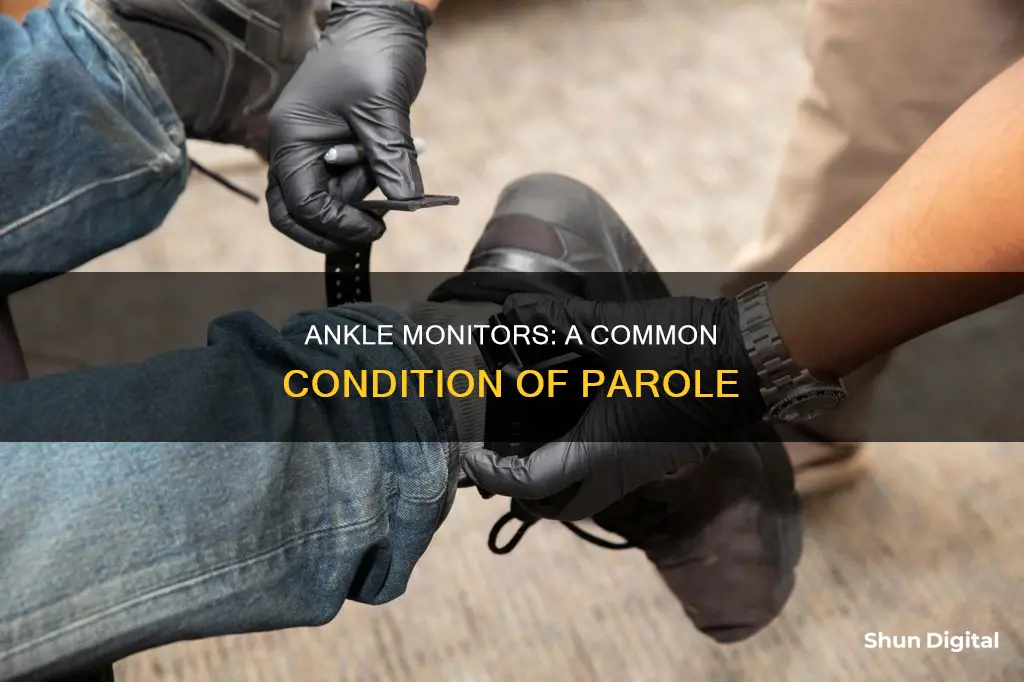
Ankle monitors are electronic devices affixed to an individual's body, typically above the ankle, to track their location and movement. They are used as an alternative to incarceration, allowing inmates to maintain jobs and relationships while serving their sentences. Ankle monitors are often employed as a condition of bail, probation, or parole, ensuring that individuals stay within designated boundaries set by the court. While they provide greater freedom compared to incarceration, ankle monitors come with restrictions and can be embarrassing for the wearer, signalling their involvement with the justice system. The use of ankle monitors has raised concerns about stigmatization and privacy, with their bulky design making them difficult to conceal.
| Characteristics | Values |
|---|---|
| Purpose | To monitor people on parole, probation or pretrial supervision |
| Type of device | GPS or radio frequency |
| Who pays for the device | The defendant |
| Cost | $5 to $25 a day |
| Who is eligible for GPS monitoring | Juvenile offenders, non-violent offenders, first-time offenders, people with a secure and stable job, people vulnerable to abuse in prison, people who are ill or incapacitated |
| Who is not eligible for GPS monitoring | People who have committed certain violent crimes |
| Appearance | Bulky and difficult to conceal |
| Alert | If the wearer leaves a specific geographic area |
| Curfew | Yes |
| Permission to leave home | Yes, for work, school, rehabilitation, treatment, groceries, medical care |
| Removal of device | A crime, may result in parole being revoked |
What You'll Learn

Parolees may need permission to leave the house
One condition of parole is that parolees must always provide their parole agent with the address of where they live and work. They must also notify their parole agent before moving to a new address. This means that parolees may need permission to leave the house, as they must have approval from their parole agent for any changes in their residence or workplace.
In addition, parolees may need permission to travel or leave the state. In Tennessee, for example, parolees generally cannot leave the state without the permission of their parole officer. If their job requires them to travel outside the state, they must obtain permission beforehand. Parolees may also need to obtain a travel pass from their parole agent before leaving the county or state and must carry this pass with them at all times.
Parolees are also subject to search and seizure conditions. They, their residence, and their possessions can be searched at any time, without a warrant or reason, by a parole agent or police officer. This means that parolees may not have privacy or autonomy even within their own homes.
To ensure compliance with these conditions, parolees may be required to wear electronic ankle monitors. These monitors use GPS and Wi-Fi to track the wearer's location, enforcing house arrest or restricting them to a certain radius. While the monitors are intended to provide surveillance and promote rehabilitation, they can also stigmatize the wearer and compromise their privacy. The bulkiness of the monitors makes it difficult to conceal them, publicly displaying the wearer's involvement with the justice system.
Monitor Refresh Rates: Finding Your Display's Speed
You may want to see also

Ankle monitors can be GPS or radio frequency devices
Ankle monitors are electronic devices that are locked around a person's ankle and are used as a surveillance tool by law enforcement. They are often used as an alternative to incarceration, with the number of people on ankle monitors rising during the COVID-19 pandemic as jails became overcrowded. Ankle monitors can be used in combination with GPS technology, but for short-range monitoring, radio frequency technology is used.
Radio frequency (RF) monitors inform the monitoring party about the general whereabouts of the device in relation to the home-based unit. They do not give an exact location but notify when the device comes into or leaves a designated area. These monitors are often used for curfew purposes and house arrest cases.
Global Positioning System (GPS) ankle monitors divulge specific geographical coordinates for the wearer. They are often very precise and can transmit location data continuously or at regular intervals. These monitors are useful for allowing individuals to travel according to prearranged schedules and for restricting some offenders from going near certain locations or people.
In most cases, an ankle monitor system consists of three main components: an ankle bracelet, an on-site receiver, and a remote receiver. The bracelet unit takes regular or constant readings of desired information, such as the user's location, and sends these readings to an on-site transmitter, usually located in the user's home, using either radio transmission or GPS technology. The readings are then relayed to a remote receiver, which may be located at a police station or monitoring service centre. If the readings indicate a breach, such as leaving the home while under house arrest, the proper authorities are alerted and act accordingly.
Easy Steps to Remove Monitor from HP ZBook 15
You may want to see also

Removing an ankle monitor is a crime
Ankle monitors, or electronic tags, are commonly used as an alternative to incarceration for people on parole, probation, or pretrial supervision. They are typically fitted above the ankle and use GPS and Wi-Fi technology to track the wearer's location, often enforcing house arrest or restricting them to a certain radius. While these monitors have been widely used since the 1980s, their design has remained largely unchanged, with bulkiness and difficulty in concealment suggesting that the stigma and visibility of the device may be intended as part of the punishment.
The use of ankle monitors has raised ethical concerns, particularly regarding the stigmatization and prejudice faced by wearers, who are often presumed to be dangerous criminals. The visibility of the monitor effectively displays the wearer's involvement with the justice system, compromising their privacy and potentially impacting their social and employment opportunities. This links to a historical tradition of shaming and marking individuals as a form of punishment.
Removing or tampering with an ankle monitor is considered a serious offense and can have significant legal consequences. In some jurisdictions, such as Florida, it is classified as a felony, and offenders may face harsh penalties, including being held without bond until their case is resolved. Even before the introduction of the felony classification, removing an ankle monitor in Florida was considered a crime and could result in charges.
The consequences of removing an ankle monitor can be severe, as it is viewed as a sign of disregard for the court system. Judges and prosecutors may lose trust in the offender and could respond by revoking any previously granted leniency or special considerations. Therefore, it is essential for individuals wearing court-ordered ankle monitors to comply with the requirements and seek legal advice if they have any concerns or issues.
Understanding EDP LCD and Monitor Technology
You may want to see also

Parolees may have to pay for their ankle monitor
The cost of the ankle bracelet can range from $5 to $40 per day, with a set-up fee of around $175 to $200. While the specific financial arrangements may vary depending on the jurisdiction and individual circumstances, it is generally the responsibility of the offender to pay any costs associated with the use of the electronic monitoring device.
In addition to the financial burden, the design of the ankle monitors has been criticised for being bulky and difficult to conceal, potentially stigmatising the wearer and displaying their involvement with the justice system. This stigma and the difficulty of hiding the monitor could be seen as part of the punishment. The data collected by the monitors also raises privacy concerns, as it freely provides information about the wearer's location and activities to anyone who notices the device.
Despite the potential drawbacks, electronic monitoring programs are increasingly used as a way to address prison overcrowding and provide an alternative to incarceration. Offenders who are considered low-risk and non-violent are more likely to be granted this type of arrangement, allowing them to serve their sentence under house arrest rather than in a correctional facility.
Updating ASUS Monitor Drivers: A Simple Step-by-Step Guide
You may want to see also

Ankle monitors can be embarrassing and stigmatising
Ankle monitors can be a source of embarrassment and stigmatisation for those who wear them. They are often bulky and difficult to conceal, making it obvious to others that the wearer may have had involvement with the justice system. This can lead to people making assumptions about the wearer's character and presuming they are dangerous criminals, even if they are low-risk offenders.
The design of ankle monitors has not changed significantly in 30 years, indicating that the stigma and difficulty of hiding them may be intentional parts of the punishment. This is in contrast to other forms of wearable technology, such as smartwatches, which are designed to be less conspicuous and sleeker. The lack of effort to reduce the size and improve the design of ankle monitors raises questions about whether this is done to intentionally stigmatise wearers.
The use of ankle monitors can compromise privacy and make it difficult for people to form social bonds within their communities. It also complicates everyday activities such as finding employment and attending school. Wearers may constantly worry about being spotted and judged by others, leading to feelings of isolation and anxiety.
In addition to the social stigma, ankle monitors can also be physically uncomfortable and restrictive. The monitors are typically strapped tightly around the ankle, and some people report that pushing them up into their pants to hide them can cause pain and numbness in the feet. This physical discomfort adds to the mental stress and embarrassment that ankle monitors can cause.
Overall, the use of ankle monitors as a form of surveillance can have negative psychological impacts on wearers, leading to feelings of stigmatisation, embarrassment, and social isolation. The design and implementation of these devices warrant further consideration to mitigate these potential harms.
IPS vs TN Panels: Quick Ways to Distinguish Monitor Types
You may want to see also
Frequently asked questions
An ankle monitor is a type of monitoring device that is worn on the ankle and cannot be removed until the court-approved date.
Ankle monitors are worn as a condition of bail, house arrest, probation, or parole. They are used as a substitute for harsher penalties, such as incarceration.
There are two types of ankle monitors: GPS devices and radio frequency devices. GPS devices always tell the parole officer the wearer's location, while radio frequency devices send a signal when the wearer leaves a prescribed geographic area.
The rules for wearing an ankle monitor can vary depending on the individual's situation. They may include sticking to a specific area, avoiding certain people, adhering to a curfew, or abstaining from drugs and alcohol. It is important to note that removing or damaging the device is not allowed and can result in legal consequences.
The cost of ankle monitors can vary, but generally, there are daily fees for using the device, which can range from a few hundred dollars to $25 per day. The person wearing the ankle monitor is typically responsible for these costs.







